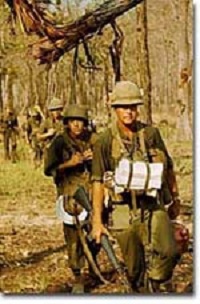
55. The Vietnam War

These young soldiers were members of the U.S. 1st Air Cavalry. This picture was taken in 1965, during the first military engagements between U.S. and North Vietnamese ground forces.
The Vietnam War was the second-longest war in United States history, after the war in Afghanistan.
Promises and commitments to the people and government of South Vietnam to keep communist forces from overtaking them reached back into the Truman Administration. Eisenhower placed military advisers and CIA operatives in Vietnam, and John F. Kennedy sent American soldiers to Vietnam. Lyndon Johnson ordered the first real combat by American troops, and Richard Nixon concluded the war.
Despite the decades of resolve, billions and billions of dollars, nearly 60,000 American lives and many more injuries, the United States failed to achieve its objectives.
One factor that influenced the failure of the United States in Vietnam was lack of public support. However, the notion that the war initially was prosecuted by the government against the wishes of the American people is false. The notion that the vast majority of American youths took to the streets to end the Vietnam War is equally false. Early initiatives by the United States under Truman, Eisenhower, and Kennedy received broad support.
Only two members of the United States Congress voted against granting Johnson broad authority to wage the war in Vietnam, and most Americans supported this measure as well. The antiwar movement in 1965 was small, and news of its activities was buried in the inner pages of newspapers, if there was any mention at all. Only later in the war did public opinion sour.
The enemy was hard to identify. The war was not fought between conventional army forces. The Viet Cong blended in with the native population and struck by ambush, often at night. Massive American bombing campaigns hit their targets, but failed to make the North Vietnamese concede. Promises made by American military and political leaders that the war would soon be over were broken.
And night after night, Americans turned on the news to see the bodies of their young flown home in bags. Draft injustices like college deferments surfaced, hearkening back to the similar controversies of the Civil War. The average age of the American soldier in Vietnam was nineteen. As the months of the war became years, the public became impatient.
Only a small percentage of Americans believed their government was evil or sympathized with the Viet Cong. But many began to feel it was time to cut losses. Even the iconic CBS newscaster Walter Cronkite questioned aloud the efficacy of pursuing the war.
President Nixon signed a ceasefire in January 1973 that formally ended the hostilities. In 1975, communist forces from the north overran the south and unified the nation. Neighboring Cambodia and Laos also became communist dictatorships. At home, returning Vietnamese veterans found readjustment and even acceptance difficult. The scars of Vietnam would not heal quickly for the United States.
The legacy of bitterness divided the American citizenry and influenced foreign policy into the 21st century.





